It is Dec. 4, 2016: a 28-year-old man, Edgar Welch, enters the Comet Ping Pong pizzeria in Washington, D.C., armed with an AR-15 assault rifle. His intention is not to cause a massacre, but simply to independently investigate a conspiracy theory that has been circulating for months. It is one of the pivot points of the affair that has gone down in history as the "Pizzagate theory," which had a major impact on the eve of the 2016 U.S. presidential election and is still a pillar of the QAnon conspiracy theory: the very supporters of QAnon (the theory that there is a “Deep State” of occult powers, composed of networks of Satanists and pedophiles, who are allegedly guilty of working against U.S. President Donald Trump) were yesterday among the main animators of theassault on Capitol Hill and the U.S. Congress. Everyone is now familiar with the images of the character who showed up at the uprising disguised as a bovine with horns and fur: he proclaims himself “the shaman of QAnon.”
And just as QAnon followers, neo-Nazis, anti-Semites, and assorted extremists stormed the U.S. Parliament, on Twitter, during the most heated stages of the attack, some users posted photos of “Satanist” works by Marina Abramović or insulted the “pedophile murderer” John Podesta, Hillary Clinton’s 2016 campaign chairman, Bill Clinton’s chief of staff between 1998 and 2001, and brother of art collector Tony Podesta. Over-interpretations of some artworks, not only by Marina Abramović but also by other artists in Podesta’s collection (Patricia Piccinini, Biljana Djurdjević, Maria Marshall, Jeff Koons, and others) played a very prominent role in spreading and fomenting the Pizzagate hoax: according to this conspiracy theory, there would exist a network of U.S. politicians and the people they associate with (Marina Abramović is among them) dedicated to human trafficking, the practice of occult rituals and the abuse of minors and children. According to plotters, one of the venues for such abuses would be the Comet Ping Pong pizzeria (hence the name “pizzagate”): Welch, on December 4, 2016, wanted to ascertain for himself that the theory was well-founded.
The Comet Ping Pong gunslinger, wrote University of Chicago professor Spencer Dew, “is the manifestation of an epistemological crisis in contemporary American,” an epistemological crisis that stems from theanxiety to know (the question that generates it, Dew argues, is “how can we know?”), that feeds on coincidences, that consumes social media and threatens mainstream journalism, that is based on an almost fideistic approach to certain beliefs. And it is a crisis, Dew writes, "facilitated by the replacement of traditional media with populist access to media, fueled by concerns about coincidences between the wealthy and positions of political power, exacerbated by situations to which the great wealthy ascribe and value (particularly contemporary art: Jeff Koons, Lady Gaga and Marina Abramović represent the focal points of terror, because of their decadence or esotericism coupled with the magical transformation of common objects into commodities)."
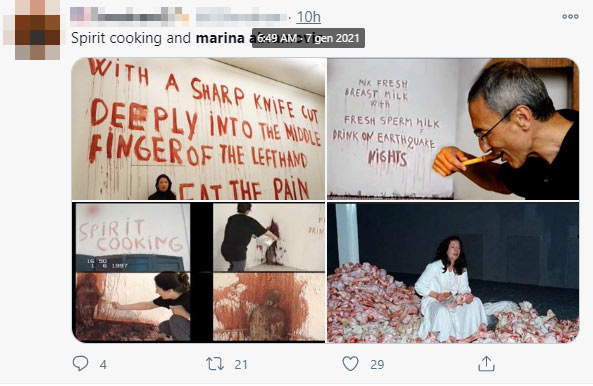 |
| Tweet by a QAnon follower on the morning of Jan. 7, against the works of Marina Abramović |
 |
| A moment of the attack on Congress on Jan. 6 |
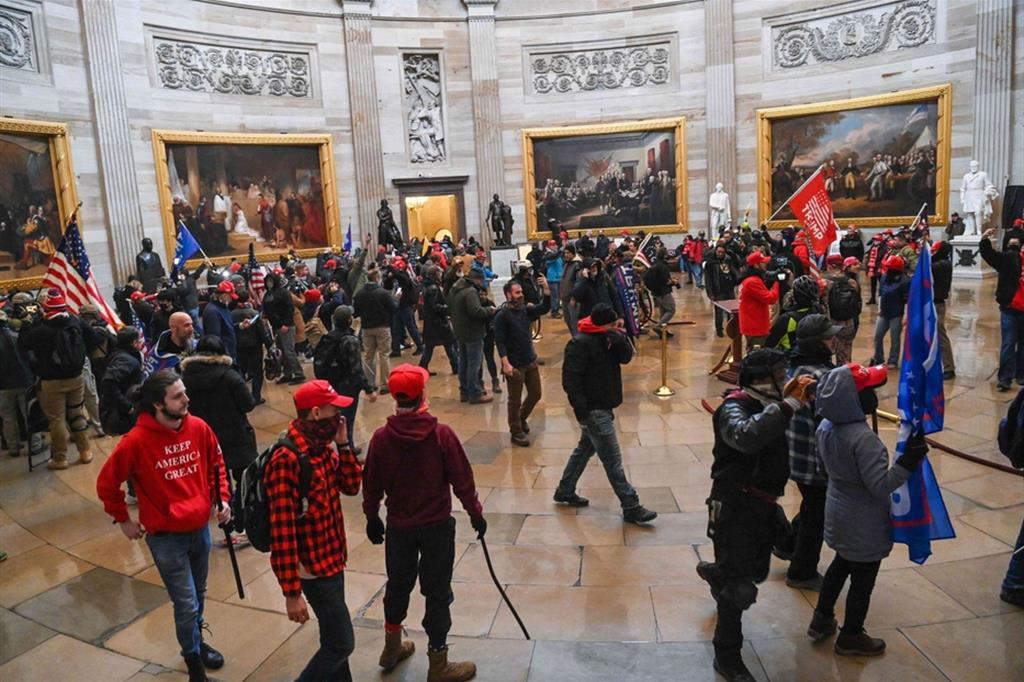 |
| A moment of the attack on Congress on Jan. 6 |
The origins of this agitation conspiracists have against artworks dates back to October 2016, when the website Wikileaks published an email sent by Marina Abramović to the aforementioned Tony Podesta, an entrepreneur and well-known art collector, moreover a regular attendee of the Venice Biennale, the owner, writes the Wall Street Journal, of a residence in Washington “where he exhibited a museum-worthy collection of artworks” (his world has since collapsed, the WSJ article also states, due to “financial problems, legal threats, and the election of President Donald Trump). The Serbian artist’s email, sent to Tony Podesta on June 28, 2015, reads, ”Dear Tony, I’m so looking forward to the Spirit Cooking dinner at my place. Do you think you would be able to let me know if your brother’s joining? All my love, Marina“ (”Dear Tony, I am so looking forward to the Spirit Cooking dinner at my place. Do you think you would be able to let me know if your brother’s joining us? All my love, Marina."). Pizzagate theorists have given a highly distorted interpretation of Marina Abramović’s words, coming to the conclusion that she and the Podesta brothers were planning to organize a satanic ritual: ideas that have easily appealed to conspiracy theorists partly because they have been fueled by popularalt-right media outlets such as InfoWars or Drudge Report that have circulated articles headlined as “Spirit Cooking: Hillary Clinton’s campaign managers practice bizarre occult rituals.”
On the imagination of the plotters, the performance Spirit Cooking by Marina Abramović, reinterpreted during the dinner, has made its mark: it is a work dating back to 1996 and until then little known, but not because the artist wanted to keep it hidden: simply because it is not among the most famous, most successful, and to tell the truth not even among the most violent, of the Belgrade-based performer’s actions. Abramović held her performance (first represented in Ghent, Belgium), also in Italy, on June 1, 1997, in the premises of the Zerynthia association in Paliano (Frosinone): a video of the “frusinate” performance is available on YouTube, and it is enough to scroll through the thousands of comments to realize how the performance is interpreted by conspiracy theorists. On the website of MIT Press, the publisher of the Massachusetts Institute of Technology, one can find a comprehensive commentary on Spirit Cooking, written by James Westcott, the artist’s biographer: during the action, Marina Abramović painted, on the white wall of the gallery, disconnected phrases, using pig blood. These were mock instructions that mixed the typical language of cooking recipes with situations from esoteric or religious imagery, for example, “with a sharp knife deeply incise the middle finger of your left hand and eat pain,” or “mix women’s milk with fresh semen and drink it on earthquake nights,” and again, “spin yourself until you lose consciousness and try to eat all the questions of the day.” Abramović blending the comic and the mystical, had also published a Spirit Cooking cookbook, where she had gathered similar instructions.
“I’ve known Marina for fourteen years,” Westcott says in his article, “I’ve written a biography of her, and I don’t think she’s ever worshipped anything. What she has done is to have used the world of spiritual, esoteric, and religious practices as a source of material for experimental performances and as meditation tools to soothe her boundless psychological pain. Essentially she takes the spiritual and squeezes it into the purely carnal. It is all about stimulation, deprivation and aesthetics to achieve certain physical effects and certain mental states. She believes in everything and therefore nothing. Except in the power of the body.” No instruction in satanic rituals, then, let alone child abuse. Her Spirit Cooking, after all, is imagined to shock the audience, just like so many of her other performances, from the more violent ones (such as Balkan Baroque, perhaps one of the most terrible, which has nothing to do with occultism, but with the far more urgent, real and painful consequences of the war in the Balkans in the 1990s), to the more “quiet” ones such as The artist is present. Nothing strange even for those who know a modicum of art history:Viennese Actionism, for example, accustomed audiences to far worse scenes. And those familiar with the practice of Marina Abramović obviously cannot but find Westcott’s words completely understandable. In fact, the American critic points out how "literal interpretations of the alt-right recall the culture wars of the 1980s and 1990s, when the line between representation and advocacy, between artifice and reality, became blurred, and apparently the lens has not yet returned to focus." Westcott recalls how Marina Abramović has stayed in some Buddhist monasteries to meditate, spent a few months with the Aborigines of Australia, and initiated actions to pay homage to St. Teresa of �?vila, but none of this makes her a Buddhist, a shaman or a Catholic, just as having drawn from esoteric imagery does not make her an occultist. She herself has defined Spirit Cooking as nothing more than “poetry.”
 |
| Marina Abramović, Spirit Cooking (1996; performance) |
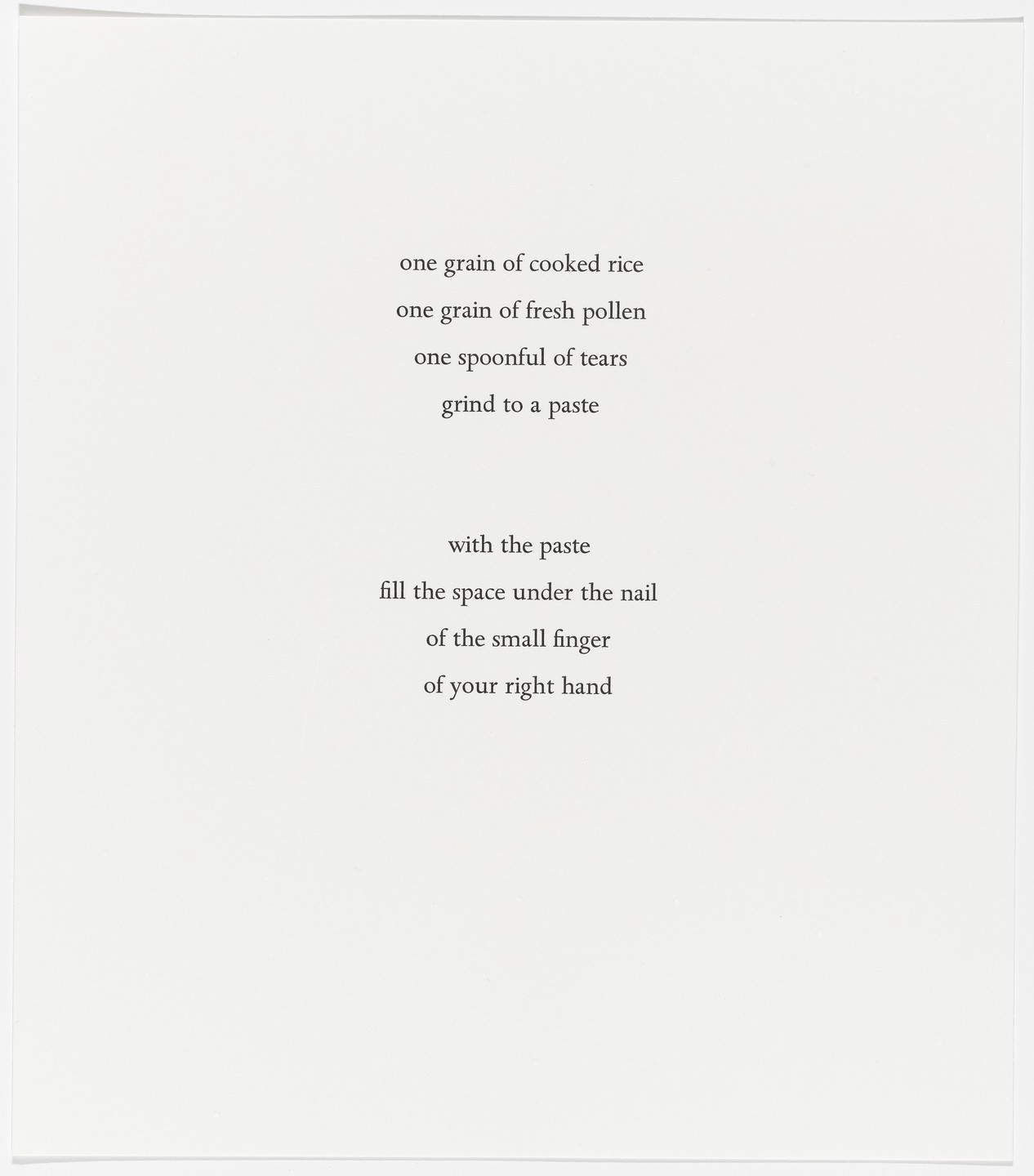 |
| Marina Abramović, Untitled, from Spirit Cooking (1996; aquatint, 31.5 x 27.8 cm; New York, MoMA) |
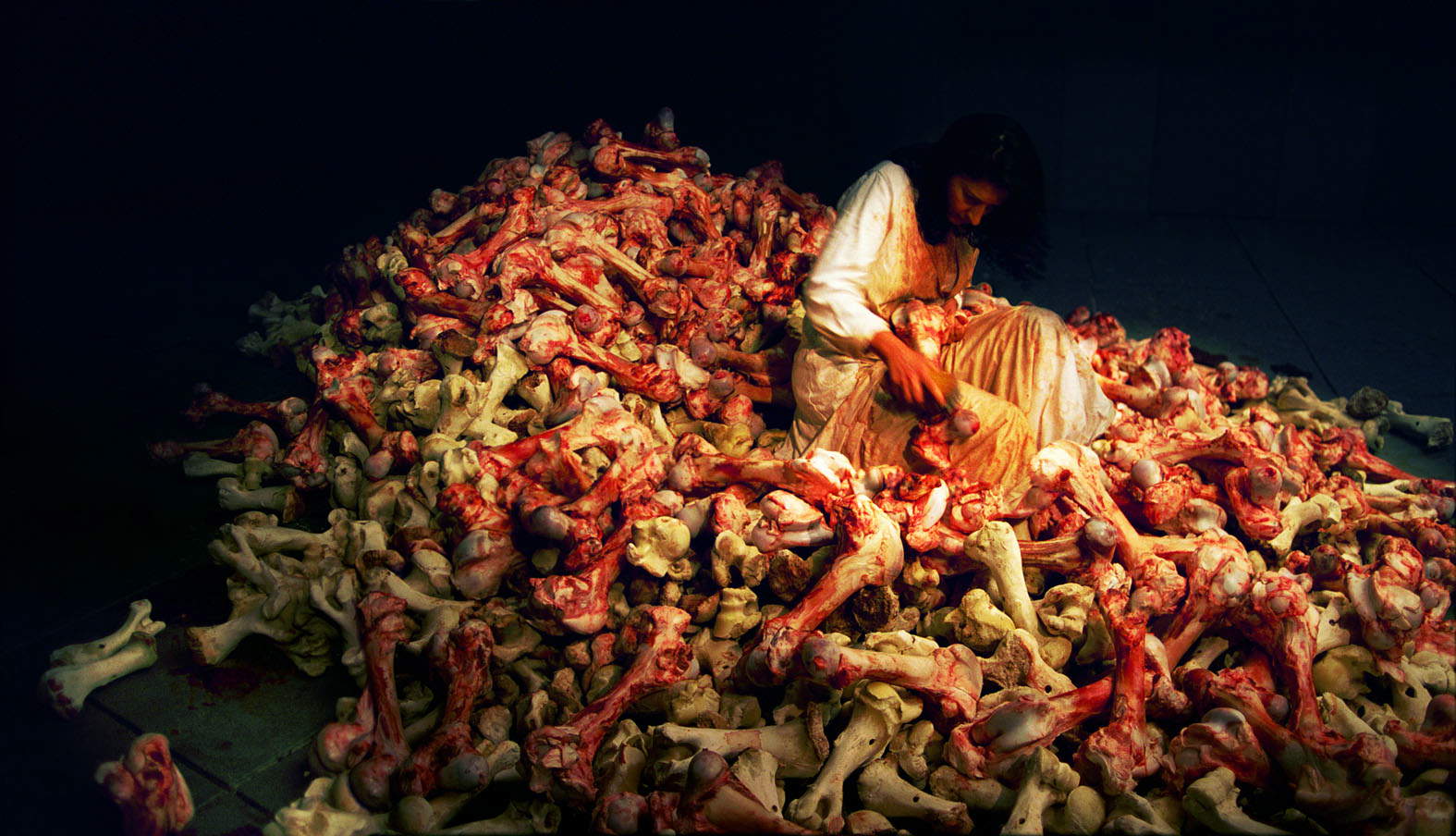 |
| Marina Abramović while performing the performance Balkan Baroque |
 |
| Marina Abramović performing at the charity event for the Watermill Center in New York, July 2013 |
Why had Marina Abramović referred to her 1996 performance in the email sent to Tony Podesta? The explanation is very simple: staging the action was the prize provided for the highest-level supporters of a crowdfunding campaign launched in 2013 on Kickstarter (the artist was seeking funds to establish an art institute in upstate New York), and for those who donated at least ten thousand dollars, “a dinner with Marina Abramović during which the artist will teach you how to cook a series of traditional soups,” was provided as a prize. The evening will end with the making of a golden ball, a recipe Marina learned in a Tibetan monastery“ (so it read on Kickstarter). The plotters, however, did not believe a word of the art critics who also spent time explaining the intent of Marina Abramović’s performance, and thanks in part to the amplifying effect of social networks, she, Tony Podesta and her brother John automatically became occultists devoted to satanic rituals. But that’s not all: the thousands of blogs and platforms of the conspiracy galaxy then began to circulate, even in Italy, some images, in which Marina Abramović and Lady Gaga are seen drawing fake blood from a tub in which a naked woman is immersed, passing them off as photographs of the so-called ”Spirit Cooking dinner." these were actually photographs from July 2013, when the artist held a benefit show in New York aimed at raising funds for the Watermill Center, an art institute in the American city. And again, nothing strange here for those who frequent the art world and are accustomed to participating in similar performative actions: however, these are images that appeal to an audience totally unfamiliar with contemporary art and, moreover, easily impressed.
Unfortunately, accusations of Satanism continue to haunt Marina Abramović even after some time: last April, for example, the artist was forced to ask YouTube to delete, from her Microsoft account, a video for her project The Life, which advertised a virtual reality device through which participants in a performance organized in 2019 at the Serpentine Galleries in London could virtually meet the artist for 19 minutes. The video was submerged in comments from plotters, so much so that it spurred Marina Abramović to publicly defend herself against the accusations and call for the removal of the film.
But the Serbian artist is not the only member of the contemporary art world to have been targeted by QAnon followers. In 2017, the Anglo-Swiss artist Maria Marshall had been reached by several of emails from plotters who had evidently discovered certain of her works, dating back to the 1990s, depicting children engaged in unsafe activities (the most notorious work being the video showing Marshall’s son smoking a cigarette). These are obviously photomontages, made to appear plausible, but they have been taken for true by followers of conspiracy theories, who have therefore accused her of being part of the Pizzagate circle, due to the fact that her name is also associated with Tony Podesta’s: the businessman and collector has in fact donated several of Maria Marshall’s works to the National Museum of Women in the Arts in Washington. They are works, reads the website of the Metropolitan Museum in New York, which preserves some of Maria Marshall’s work, that speak to “maternal fears and fears associated with the commodification of childhood in Western culture.” Works, of course, provocative, but certainly not associated with pedophile practices as conspiracy theorists would have it. In a YouTube video, reads an Artnet magazine article, a conspiracy theorist introduced Maria Marshall’s images by warning that “there are things I couldn’t show you, things you won’t be happy about,” and that he could not expose the artist because “the conspiracy has infiltrated even the FBI.” The accusations were such that they also provoked a retort from Maria Marshall’s children, also reported by Artnet (“but who are these people who have nothing better to do than waste their time spreading false rumors?”).
The list of artists caught in the crosshairs of QAnon supporters could go on and on. Jeff Koons (who made some donations to Hillary Clinton’s campaign in 2016) for his works referencing the world of cartoons and childhood in general, Serbian Biljana Djurdjević (one of her paintings can be seen in the photograph of a room in Tony Podesta’s house published in 2015 by Washington Life Magazine) for her paintings depicting children in the process of being tortured (and which in fact, as well explained in the introductory text of one of her exhibitions held at the Moderna Museet in Stockholm between 2006 and 2007, refer, if anything, to the vulnerability of the youngest children in the face of the media and, in general, to the violence that children suffer every day in all parts of the world: so if anything, these are paintings of condemnation and not of approval), Patricia Piccinini (another artist in the Podesta collection) for her realistic sculptures depicting monsters undermining children. Even some plotters have lashed out at a sculpture by Louise Bourgeois, which appears in the Washington Life Magazine article where she is identified as one of Tony Podesta’s favorites, because the woman depicted would bear a vague resemblance to the victim of a serial killer who killed seventeen people in the early 1990s.
 |
| Maria Marshall, When I Grow Up I Want to Be a Cooker (1998; single-channel video; New York, Metropolitan Museum of Art) |
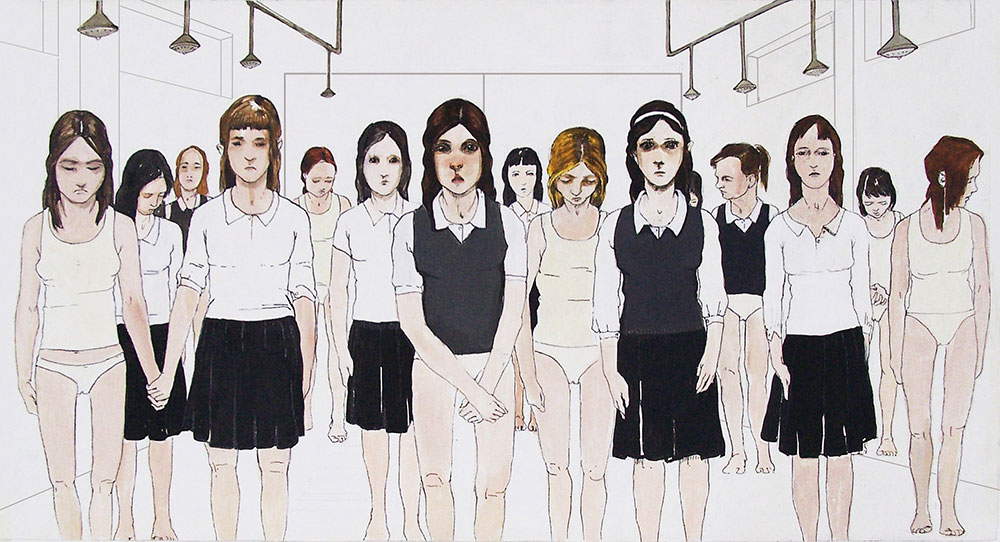 |
| Biljana Djurdjević, The future brings us nothing! (2010; ink, pen and acrylic on canvas, 38 x 71 cm) |
 |
| Patricia Piccinini, Undivided (2004; silicone, human hair, mixed media, 101 x 74 x 127 cm) |
Several newspapers have debunked the theories of Pizzagate and the followers of QAnon: one can find many articles in newspapers such as theObserver, Huffinton Post, CNN, and several other reliable sources. There are articles on the theory in general, but also on individual topics: a media outlet such as USA Today, for example, found itself forced to publish a debuking article entitled: “Fact check: there is no evidence to support rumors that Lady Gaga is a witch” (a headline that, in the 21st century, perhaps should make us reflect on what we have done wrong). In Italy (where there is no shortage of followers of QAnon, but where very little is said about these issues: the name began to recur only after last night’s events) the work done by Formiche.net and theInternazionale, with articles by writer Wu Ming 1, is noteworthy.
Writer Robert Guffey, in his article in Salon magazine, described QAnon as “a conspiracy theory covering everything from Pizzagate to Kanye West to Marina Abramović” “I wonder,” Guffey wrote, “if any of QAnon’s followers ever heard of this top-notch artist [Marina Abramović; ed.] or her work before the rumors started circulating through the nooks and crannies of 4chan. I imagine a couple of guys, in their average American male lair, surfing the Internet drinking Red Bull or Keystone Light [a cheap American beer, ed.] and coming across out-of-context photographs of Marina Abramovi&cacute’s performances;, they get aroused as they imagine her opening her legs for Lucifer or Baphomet or Moloch or Tom Hanks or Bill Clinton, become overexcited and at the same time are in the grip of religiously based guilt, and immediately run into a chat room to condemn Abramović for her seductive ways.”
Art, therefore, also played no small role in igniting the spirits of those who stormed the Congress yesterday, given also the well-known power of images, combined with the “epistemological crisis” mentioned in the opening and the difficulty of accepting that a reality can be much simpler and less hidden than how it is presented. Imagine what it may mean to replicate on thousands of blogs and social accounts images of Marina Abramovi&cacute’s works; with completely misleading captions or descriptions: one can very easily guess the risks. So what to do? The answer lies in correct information, even if the results can be frustrating. Marina Abramović for example, on the occasion of the controversy that arose over the April 2020 video mentioned above, she let the New York Times know that she would even be willing to welcome plotters to her performance The artist is present, to help them understand her work. But that may not be enough. “Their energy,” the artist said, “is fueled by conspiracy theory. And they don’t have another theory to replace it.”
 |
| How the conspiracy of the Capitol Hill attackers was fueled by art |
Warning: the translation into English of the original Italian article was created using automatic tools. We undertake to review all articles, but we do not guarantee the total absence of inaccuracies in the translation due to the program. You can find the original by clicking on the ITA button. If you find any mistake,please contact us.